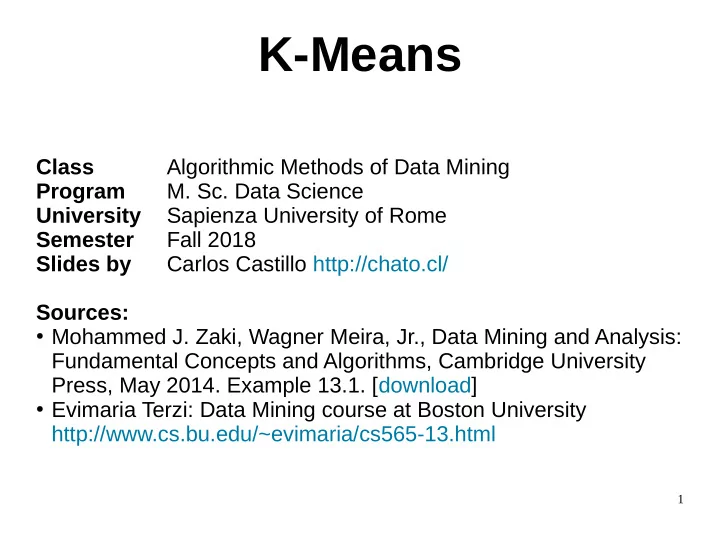

K-Means Class Algorithmic Methods of Data Mining Program M. Sc. Data Science University Sapienza University of Rome Semester Fall 2018 Slides by Carlos Castillo http://chato.cl/ Sources: ● Mohammed J. Zaki, Wagner Meira, Jr., Data Mining and Analysis: Fundamental Concepts and Algorithms, Cambridge University Press, May 2014. Example 13.1. [download] ● Evimaria Terzi: Data Mining course at Boston University http://www.cs.bu.edu/~evimaria/cs565-13.html 1
The k-means problem Boston University Slideshow Title Goes Here • consider set X={x 1 ,...,x n } of n points in R d • assume that the number k is given • problem: • find k points c 1 ,...,c k (named centers or means) so that the cost is minimized 2
The k-means problem • k=1 and k=n are easy special cases ( why? ) Boston University Slideshow Title Goes Here • an NP-hard problem if the dimension of the data is at least 2 (d≥2) • in practice, a simple iterative algorithm works quite well 3
The k-means algorithm Boston University Slideshow Title Goes Here • voted among the top-10 algorithms in data mining • one way of solving the k- means problem 4
K-means algorithm 5
The k-means algorithm Boston University Slideshow Title Goes Here 1.randomly (or with another method) pick k cluster centers {c 1 ,...,c k } 2.for each j, set the cluster X j to be the set of points in X that are the closest to center c j 3.for each j let c j be the center of cluster X j (mean of the vectors in X j ) 1.repeat (go to step 2) until convergence 6
Sample execution Boston University Slideshow Title Goes Here 7
1-dimensional clustering exercise Exercise: ● For the data in the figure ● Run k-means with k=2 and initial centroids u1=2, u2=4 (Verify: last centroids are 18 units apart) ● Try with k=3 and initialization 2,3,30 8 http://www.dataminingbook.info/pmwiki.php/Main/BookDownload Exercise 13.1
Limitations of k-means ● Clusters of different size ● Clusters of different density ● Clusters of non-globular shape ● Sensitive to initialization 9
Limitations of k-means: different sizes Boston University Slideshow Title Goes Here 10
Limitations of k-means: different density Boston University Slideshow Title Goes Here 11
Limitations of k-means: non-spherical shapes Boston University Slideshow Title Goes Here 12
Effects of bad initialization Boston University Slideshow Title Goes Here 13
k-means algorithm Boston University Slideshow Title Goes Here • finds a local optimum • often converges quickly but not always • the choice of initial points can have large influence in the result • tends to find spherical clusters • outliers can cause a problem • different densities may cause a problem 14
Advanced: k-means initialization 15
Initialization Boston University Slideshow Title Goes Here • random initialization • random, but repeat many times and take the best solution • helps, but solution can still be bad • pick points that are distant to each other • k-means++ • provable guarantees 16
k-means++ Boston University Slideshow Title Goes Here David Arthur and Sergei Vassilvitskii k-means++: The advantages of careful seeding SODA 2007 17
k-means algorithm: random initialization Boston University Slideshow Title Goes Here 18
k-means algorithm: random initialization Boston University Slideshow Title Goes Here 19
k-means algorithm: initialization with further-first Boston University Slideshow Title Goes Here traversal 2 1 3 4 20
k-means algorithm: initialization with further-first Boston University Slideshow Title Goes Here traversal 21
but... sensitive to outliers Boston University Slideshow Title Goes Here 2 1 3 22
but... sensitive to outliers Boston University Slideshow Title Goes Here 23
Here random may work well Boston University Slideshow Title Goes Here 24
k-means++ algorithm • interpolate between the two methods Boston University Slideshow Title Goes Here • let D(x) be the distance between x and the nearest center selected so far • choose next center with probability proportional to (D(x)) a = D a (x) ✦ a = 0 r a n d o m i n i t i a l i z a t i o n ✦ a ∞ f = u r t h e s t - fj r s t t r a v e r s a l ✦ a = 2 k - m e a n s + + 25
k-means++ algorithm • initialization phase: Boston University Slideshow Title Goes Here • choose the first center uniformly at random • choose next center with probability proportional to D 2 (x) • iteration phase: • iterate as in the k-means algorithm until convergence 26
k-means++ initialization Boston University Slideshow Title Goes Here 3 1 2 27
k-means++ result Boston University Slideshow Title Goes Here 28
k-means++ provable guarantee Boston University Slideshow Title Goes Here • approximation guarantee comes just from the first iteration (initialization) • subsequent iterations can only improve cost 29
Lesson learned Boston University Slideshow Title Goes Here • no reason to use k-means and not k-means++ • k-means++ : • easy to implement • provable guarantee • works well in practice 30
k-means-- ● Algorithm 4.1 in [Chawla & Gionis SDM 2013] 31
Recommend
More recommend